Back to school
The new academic year is about to start for many colleagues around the world. This post was written in response to those who have asked me what my top tips for successful teaching and learning would be. I initially came up with a twenty bullet points list. I subsequently reduced the list to 15 items, prioritising what the 6,000 teachers and lecturers who have attended my workshops this year identified as their most important take-aways from the sessions.
My top teaching-and-learning tips for the new academic year
1. Promote self-efficacy: set your students up for success.
Self-efficacy (i.e. can-do attitude) is one of the most potent predictors of language learning success (Macaro, 2003). A self-efficacious student has high expectancy of success at the language tasks you stage in the classroom and at language learning in general; s/he is more likely to be intrinsically motivated and resilient. Self-efficacy is built through repeated experiences of success at a task; hence, it must be nurtured carefully, day in day out.

Instructional strategies that can be used to enhance self-efficacy include: minimizing cognitive load; controlled input-output; scaffolding understanding and production (e.g. through worked examples); pre-task planning; cooperative strategies; etc. (Conti and Smith, 2019).
Considering that FLA (foreign language anxiety), a powerful inhibitor of self-efficacy is rampant in language learning classrooms, teachers must endeavour to create the optimal conditions for learner success without dumbing down teaching and learning (Conti and Smith, 2019). Student self-efficacy is particularly low in Listening because of its test-like nature in many language classrooms (Graham, 2017). Hence, teachers may want to find ways to lower the students’ anxiety in this skill area and design tasks the students enjoy, succeed at and learn from.
Finally, Consider the cognitive load that the input you give and the tasks you set your students cause them: can they handle it? (see point 8 below).

2. Teach for learning, not coverage.
Don’t rush through content because the textbook does ! Let’s be mindful of human forgetting rates (see the curve of human forgetting below); most of what you have taught on day 1 will be forgotten by day 7 in the absence of regular spaced recycling (Ebbinghaus, 1885). Hence, recycle each lesson’s target items as much as possible across as many modalities as possible.
Ensure your students receive extensive practice in the target items across a wide range of contexts– this is key as we know that learning is context-specific (the so-called T.A.P. or transfer appropriate processing principle). Coursebooks unfortunately rarely do that, so you will have to heavily supplement them with your own activities and resources.
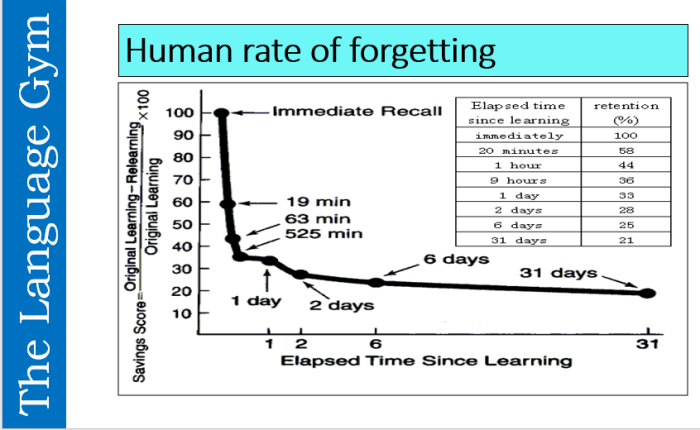
The recycling matrix below can help you ensure the core target items in your syllabus are revisited receptively and productively many times over throughout the year and that the core content is interleaved.
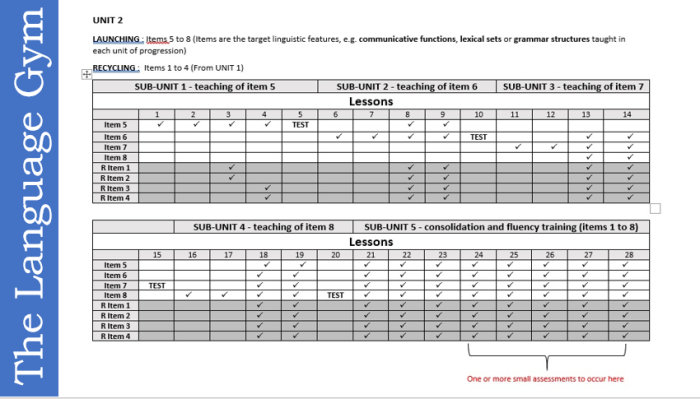
In many schools the course is too heavy on content, especially at beginner to intermediate levels (e.g. UK years 7 to 9) and often students complain that the teacher is going too fast. This is often due to the fact that the schemes of learning are based on the pace suggested by the textbook.
If you are using a UK textbook such as Studio, Expo, Zoom, Stimmt, Viva and Mira and you cover a unit from that textbook per half-term, you may be going too fast. These books do not recycle sufficiently. Devote double the time to that unit. Make ‘Less is more’ your motto. Fluency and automaticity, the ultimate goals of language learning (see point 15 below), require extensive processing and productive practice.
3.Put listening and speaking first.
Language lessons, especially in the formative years of learning, should be mostly about sound (Conti and Smith, 2019). Humans are hard-wired to learn language through sound, and memory of words is mediated by sound, even when we read silently (Field, 2009). Hence making language learning mainly about reading and writing may actually hinder L2 acquisition. Since 45 % of human communication occurs through the aural medium, – and only 25% through reading and writing – listening is the most crucial skill for survival in the target language country.

With beginner to intermediate students, a typical lesson ought to involve listening at least 60 to 70 % of the time. And since most listening tasks usually involve other skills and enhance learning by virtue of this multi-skill synergy, you won’t be neglecting reading, speaking and writing either ! Examples:
- Traditional reading aloud and reading aloud games a la Conti (e.g ‘Robo de tarjetas’ or ‘Sentence stealer’) involve speaking and reading – even writing if the students are asked to make their own sentences;
- dictations, from simple transcription tasks to dictocomp and dictogloss, involve listening, writing and reading;
- activities on songs can involve all four skills;
- favourites of mine such as Spot the difference, Bad translation, Spot the intruder, Spot the missing detail, Gapped parallel texts and others involve reading, listening and writing.

4. Make your listening and reading tasks opportunities to learn new language items and consolidate old ones.
Ask yourself:
- Does this task feel and look like a test?
- Is this listening activity / task modelling speaking?
- Am I dwelling on this text sufficient time for my students to learn?
- If what we hear lingers in the brain only a few seconds, am I giving my students opportunities to learn from the aural input they have just processed by staging post-tasks that recycle the language in that input?
5. Use a triadic routine for complex tasks (Ellis, 2015; Rost, 2016; Conti and Smith, 2019)
- Phase 1: Have a pre-task phase which prepares the students as thoroughly as possible for tasks. The preparation could have a metacognitive component (e.g. how can I prevent errors I made before in executing the same task?); a linguistic component drilling in the less familiar language items needed to complete the task and even an affective component aimed at lowering anxiety. Research shows that this preparation, if thoroughly and effectively carried out, contributes to lessening the cognitive load during the execution of the task.
- Phase 2: students execute the task. Ensure the task falls within the students’ zone of proximal development. If it involves the receptive skills ensure it includes comprehensible input and if it involves output, feasible output.
- Phase 3: After the task has been completed, have a post-task phase in which you review the performance, address any identified issues and consolidate the linguistic content. This doesn’t mean a ten-minute task, but possibly a series of logically sequenced activities which recycle the key items, help student get better at using them and addresses errors and misgivings. This phase could also include a repetition of the task done in Phase 2.
6. Don’t go to production until you have evidence that your students have consolidated sounds, vocabulary or grammar item receptively.
Give your students plenty of practice through listening and reading tasks before you make them write and/or speak. De Jong (2005) points out that when students produce L2 items which have not been consolidated receptively, they are more likely to make mistakes. Brain imaging research indicates that when students listen the brain is simultaneously ‘speaking’ silently, as it were, as listening activates the same neuronal paths that are normally in use when we speak (except the motor cortex involved in physically producing sounds). In other words, speaking doesn’t mirror listening; listening is speaking without the articulation of sounds.
As the picture below shows, do lots of extensive ear training before asking students to venture into the production of sounds, especially the more challenging ones.
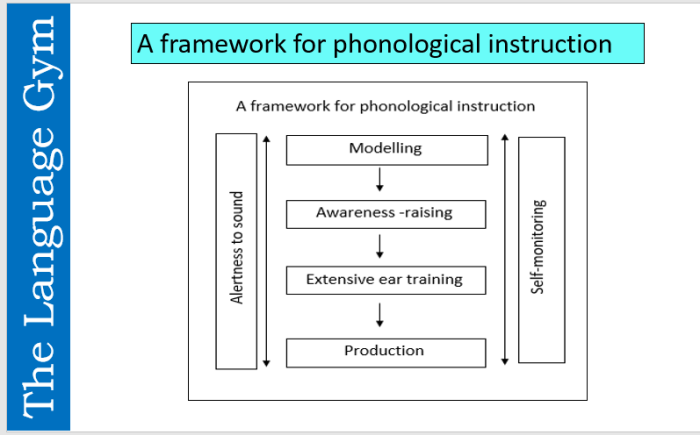
7. Teach sentence patterns and high-frequency chunks in context.
Grammar can’t be taught like a math formula: applying a fixed formula to the sentences without the understanding of the meaning in context. Vocabulary can’t be just learned by memorizing without understanding how actual words are used in a sentence.
With beginner to lower-intermediate students, lists of single words are pretty much useless unless the students are fluent in the use of sentence patterns or are very gifted at applying grammar rules to chunk them together as they produce output. It has been calculated by many researchers that 50 % at least of what we write amount to multi-words units; the figure is greater for spoken output. Here is a classification of chunks by Michael Lewis (1990), the father of the lexical approach (you can find a much more fine-grained one in Gustaffson and Verspoor, 2017).
Table 1: classification of lexical items by Lewis (1990)
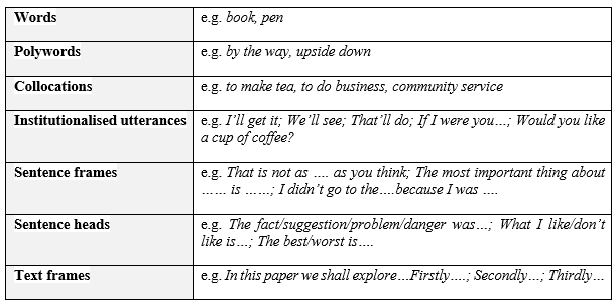
Use sentence builders like the one below to model sentence patterns, collocations and colligations.

Focus on single words only when your students are more advanced and master a wide range of sentence frames they can slot those words in. Flooding your aural and written input with many repetitions of the target sentence patterns is a very effective way of teaching them. Forced written and oral output containing many occurrences of the same target patterns will reinforce the learning of those patterns resulting in greater fluency.
Teaching chunks this way doesn’t mean avoiding teaching your students the grammar that keeps the chunk together. It means securing strong implicit learning of those patterns first; the explicit learning can occur at a later stage, through ‘reverse-engineering’, so to speak.
8.Teach as early and deeply as possible function words (determiners, prepositions, connectives, etc.)
Function words are the words that glue content-words, phrases and sentences together. They give us important clues about meaning when we listen and read and help us piece together lexis and discourse when we speak and write. Have you ever wondered why many of your final-year students are still not fluent in the recognition and production of connectives, prepositions and even determiners?
The reason is that these words are less noticeable and learnable because they are less semantically and physically salient in the input our students process; hence, unless your texts are packed with occurrences of these words and your tasks focus their students on those words, they will never acquire them. Using input-enhancement techniques (e.g. exaggerating their pronunciation when you speak; using typographic devices to make them more noticeable and distinctive;etc.) evidently helps substantively too, as it promotes noticing.

9.Avoid cognitive overload
Think about the cognitive complexity of the language items you are planning to teach and of the task you intend to stage to practise them. Also consider the language items you are aiming to teach and ask yourself: how many cognitive steps does learning those items entail? Are those steps challenging? If the answer is yes, then their cognitive load is likely to be high.
Plan for ways to scaffold comprehension and don’t refrain from using the students’ first language to facilitate learning. Avoid teaching too many paired associates which interfere with each other such as words with their synonyms or antonyms, or words that look or sound very similar, as research shows they cause interference (Nation and MacAlister, 2015). Consider the learning burden of words (see figure 1 below, adapted from Nation, 2007). Use dual coding (e.g. visual and audio input) to facilitate learning. Avoid getting the students to listen to lengthy explanations on audio or video.
Table 2. The learning burden of a word (Nation, 2007)
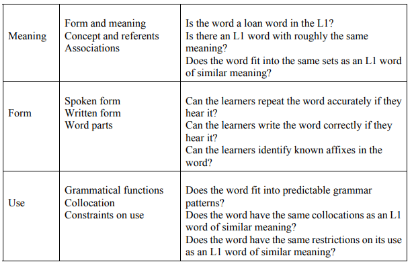
Another dimension of cognitive load pertains to the input we give our students. According to research (e.g. Nation and Hu, 2015), the vast majority of L2 learners learn very little from a text which is less than 95 % comprehensible without support. A minority of gifted learners can cope with 90% comprehensible input. Do you give your students, especially when you test them, 90 to 95 % comprehensible input? If you don’t, do you ensure you prepare them thoroughly for that task, bearing in mind that learning the words they are going to hear in a text from a worksheet prior to listening to / reading it won’t help substantively the average learner?
10.Practise selective error correction.
Teachers spend on average 1 minute of their precious time correcting 100 words of their students’ written output with very modest returns: around 10 % after six months of corrections (Chandler, 2006). And many mistakes are resistant to correction (Conti, 2005, Alroe,2003).
To enhance the effectiveness of your feedback you may want to reduce the number of errors you focus your corrections on. There is evidence that selective error correction which focuses on a very narrow range of errors is more effective than correction which focuses randomly on all or most of the errors in an essay. With younger learners, target only two or three major error categories per term. This will increase your students’ attention to those error types whilst making the corrective process easier and more purposeful for both you and your students. Here are the benefits of focused error correction:
- it concentrates on only two or three major target areas (so that their attentional resources can be used more efficiently);
- such areas are perceived as relevant to their current learning (so that they feel more motivated to address them);
- it provides frequent feedback on the same target areas week in week out (so that it enhances their understanding and keeps them constantly focused on the same error types week in week out);
- students have the declarative knowledge for self-correcting the errors with minimal prompting by the teacher (so that students are self-reliant in the process);
11.Make learning as interpersonal as possible
L2 learning should involve a balance of focus on meaningful interaction and focus on form. Many of the form-orientated and meaning-based activities language teachers stage as individual work can be turned into interactional tasks/games with a bit of creativity and imagination on our part. Nation and Newton (2009) and Conti and Smith (2019) detail a wide range of listening activities which involve interaction between teachers and students and between students.
12. Focus as much on meaning as you do on form.
Stage activities, tasks and games which focus students on phonemes, morphology and syntax and others that focus on communication. For instance, you could stage awareness-raising activities to draw your students’ attention to a specific item you want to teach (focus on form); followed by drills consolidating that items (focus on form); then stage communicative tasks which involve negotiation of meaning (e.g. Find someone who; surveys; Post and praise; Detectives and informants; Ask and move: Spot the difference; Things in common; Expert jigsaw; Listen, Recall and Repeat; etc.); finally, you could stage a few activities to address frequent errors you noticed during the communicative tasks, thereby focusing on form again.
13.Set fluency as the ultimate goal of your teaching.
Fluency ought to be the ultimate goal of your teaching. Hence, ensure that, once your students ‘know’ the items you have been teaching throughout a unit, they are given plenty of opportunities to use them across all 4 macro-skills and as wide as possible a range of communicative contexts with one goal in mind: the ability to understand and produce language accurately, as effortlessly and fast as possible.
This entails lots of task repetition and executing the same task under increasingly challenging time constraints. Tasks such as Nation’s (2001) ‘4,3,2 technique’ and ‘Market place’ and Linked-skills tasks or Conti’s ‘Oral fluency cards’, ‘Fast and furious’, ‘Chain reaction’ and ‘Pyramid translation’ involve tons of repetition and challenge the learners to produce the same output at an increasingly higher rate of speed.
If you don’t have time for this fluency-training stage think of ways to make time for it – it is so essential! One solution is to reduce the content of the curriculum; another is laid out in point (14) below.

14. Avoid time-consuming high-stake end-of-unit tests
In many UK secondary schools, a substantive portion of each term is devoted to the preparation and staging of end-of-unit high-stake assessments. In many of the schools I have worked at or visited over the years, five lessons or more are ‘wasted’ revising for the end-of-unit test, doing the test and then going through it and set useless targets. The end-result? Students who learn to the test, cramming rather than spacing out learning; results which give us an artificial and unreliable snapshot of our students’ progress and do not really advance learning.
Better replace those high-stake end-of-unit tests with several snappy and easy-to mark low-stake assessments which tell us how students are progressing over the course of the term-at-hand. This repeated-measures assessment mode provides more reliable data whilst enabling the teacher to spot deficits as the term progresses allowing him/her to address them before it is too late. The time usually devoted to high-stake end-of-unit tests could then be devoted to the fluency training alluded to in point (13).

15.Make language learning less of an intellectual endeavour for the few
Language learning should be as inclusive as possible. By making it intellectual and making it more about processing than memorizing through lots of exposure and use, you may penalize the less gifted linguists from day one of your grammar teaching. As Schmitt (1999) points out ‘Processing language is much more complicated than memorizing it‘.
Hence, model useful, high-frequency ready-made chunks for students to memorize; give them masses of opportunities to process those chunks receptively (through listening and reading 95 % comprehensible input) and then produce them in feasible output. This will speed up the onset of fluency because anyone can memorize and recall multi-word chunks, but only a few gifted beginners can piece words together accurately applying grammar rules on the spot -‘online’ – under communicative pressure. Read this if you are interested in finding out how I suggest this can be done.
16. Concluding remarks
I hope you found the above reminders useful. In case you are wondering which five tips I removed from the original list, here they are:
- Decide on the key pedagogic principles that should underpin teaching and learning in your department;
- Create a vocabulary-rich learning environment;
- Get the students to process texts extensively, at every level of grain:
- Establish a great rapport with your students. This is as – if not more – important as pedagogic principles and techniques;
- Be the most empathetic and sympathetic colleague you can be. With every one of your colleagues – not only the ones you like.
If you want to find out more about the above principles and techniques and on how they can be implemented in the language classroom, do get hold of the book I have co-authored with Steve Smith, “Breaking the sound barrier: teaching learners how to listen”, available on Amazon

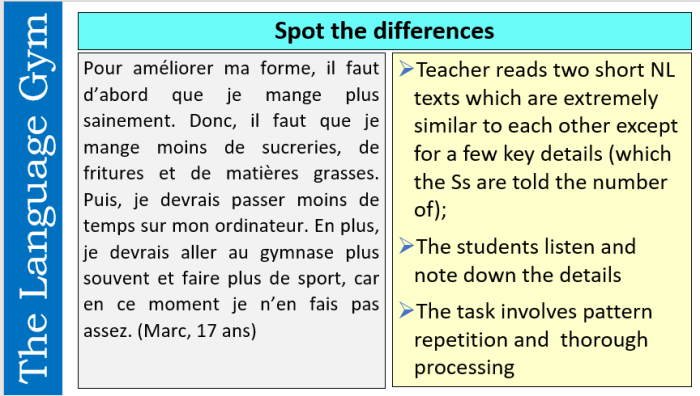
great
On Sat, Aug 31, 2019 at 5:22 PM The Language Gym wrote:
> Gianfranco Conti, Phd (Applied Linguistics), MA (TEFL), MA (English Lit.), > PGCE (Modern Languages and P.E.) posted: “Back to school The new academic > year is about to start for many colleagues around the world. This post was > written in response to those who have asked me what my top tips for > successful teaching and learning would be. I initially came up with a > twenty-bul” >
LikeLike
Hi!
Just to let you know that we’ve shortlisted this blog post for this month’s TeachingEnglish blog award and I’ll be putting up a post about it on today’s TeachingEnglish Facebook page http://www.facebook.com/TeachingEnglish.BritishCouncil, if you’d like to check there for comments.
Best,
Ann
LikeLiked by 1 person
Excellent article! Very useful, indeed!
LikeLike